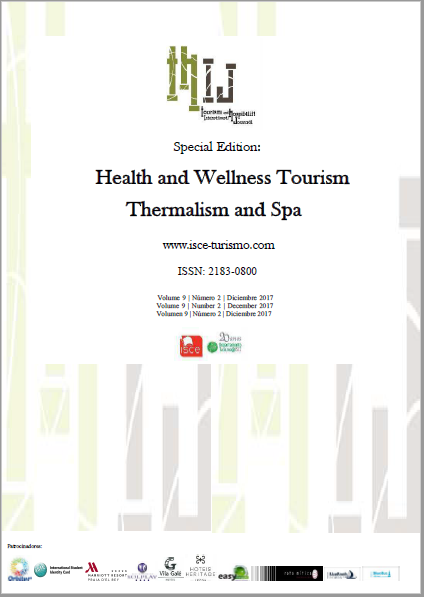Revisão da literatura: efeitos da água termal sulfurosa em casos de reumático
DOI:
https://doi.org/10.57883/thij9(2)2017.30473Palabras clave:
enfermedades reumáticas, balneoterapia, agua termal, agua sulfurosaResumen
Introducción: El termalismo consiste en el uso de agua mineral natural y otros medios complementarios con fines preventivos, terapéuticos, de rehabilitación o de bienestar. O uso de água sulfurosa é o tipo de água com maior número de indicações terapêuticas, com indicação para utilizadores com patologias reumáticas. El objetivo: analizar el estado del arte de los balnearios termales, a través del estudio de protocolos de investigación sobre los efectos del agua termal sulfurosa en casos reumáticos. Metodología: Los artículos seleccionados se recuperaron de las bases de datos Pubmed, Science Direct y Cochrane. Los criterios de inclusión fueron definidos como a) publicación en inglés, francés o portugués entre el año 2000 y la actualidad; b) modelo experimental y c) uso de agua de tipo sulfurosa. El criterio de exclusión fue que el área de investigación del artículo no estuviera dirigida a la fisioterapia. En total se encontraron 51 artículos relativos a patologías reumáticas. Resultados: La búsqueda realizada dio como resultado 6 artículos sobre los efectos de las aguas sulfurosas en patologías reumáticas. Conclusión: se constató que las aguas sulfurosas tienen efectos positivos en usuarios con patologías reumáticas. Son necesarios más estudios en este ámbito para reforzar estos resultados.
Citas
Ablin, J. N., Häuser, W., & Buskila, D. (2013). Spa treatment (balneotherapy) for fibromyalgia-a qualitative-narrative review and a historical perspective. Evidence-Based Complementary and Alternative Medicine, 2013, 638050. https://doi.org/10.1155/2013/638050
Albertini, M. C., Dachà, M., Teodori, L., & Conti, M. E. (2007). Drinking mineral waters : biochemical effects and health implications – the state-of-the-art. International Journal Environmental Health, 1(1), 153–169.
Antunes, J. (2003). O turismo de saúde e bem-estar como factor de desenvolvimento : estudo da região Dão Lafões ( NUTS III ), 1281–1302.
ASSOCIAÇÃO DAS TERMAS DE PORTUGAL. (2015). Termas de Portual. Retrieved from http://www.termasdeportugal.pt/
Auzanneau, N., & Lamerain, E. (2006). Enquête curistes 2006: Résultats redressés. Conseil National Des Exploitants Thermaux.
Bender, T., Karagülle, Z., Bálint, G. P., Gutenbrunner, C., Bálint, P. V., & Sukenik, S. (2005). Hydrotherapy, balneotherapy, and spa treatment in pain management. Rheumatology International, 25(3), 220–224. https://doi.org/10.1007/s00296-004-0487-4.
Benedetti, S., Canino, C., Tonti, G., Medda, V., Calcaterra, P., Nappi, G., … Canestrari, F. (2010). Biomarkers of oxidation, inflammation and cartilage degradation in osteoarthritis patients undergoing sulfur-based spa therapies. Clinical Biochemistry, 43(12), 973–8. https://doi.org/10.1016/j.clinbiochem.2010.05.004
Cantista, A. P. P. (2010). O termalismo em Portugal. Anales de Hidrología Medica, 3, 79–107.
Cimbiz, A., Bayazit, V., Hallaceli, H., & Cavlak, U. (2005). The effect of combined therapy (spa and physical therapy) on pain in various chronic diseases. Complementary Therapies in Medicine, 13(4), 244–50. https://doi.org/10.1016/j.ctim.2005.08.004
Coccheri, S., Gasbarrini, G., Valenti, M., Nappi, G., & Di Orio, F. (2007). Has time come for a re-assessment of spa therapy? The NAIADE survey in Italy. International Journal of Biometeorology, 52(3), 231–237. https://doi.org/10.1007/s00484-007-0117-4
Costantino, M., Filippelli, A., Quenau, P., Nicolas, J.-P., & Coiro, V. (2012). [Sulphur mineral water and SPA therapy in osteoarthritis]. Thérapie, 67(1), 43–8. https://doi.org/10.2515/therapie/2012002
Evcik, D., Kavuncu, V., Yeter, A., & Yigit, İ. (2007). L’efficacité de la balnéothérapie et des boues thermales chez des patients souffrant de gonarthrose. Revue Du Rhumatisme, 74(1), 66–71. https://doi.org/10.1016/j.rhum.2006.03.024
Fazaa, a, Souabni, L., Ben Abdelghani, K., Kassab, S., Chekili, S., Zouari, B., … Zakraoui, L. (2014). Comparison of the clinical effectiveness of thermal cure and rehabilitation in knee osteoarthritis. A randomized therapeutic trial. Annals of Physical and Rehabilitation Medicine, 57(9–10), 561–9. https://doi.org/10.1016/j.rehab.2014.09.007
Fioravanti, A., Valenti, M., Altobelli, E., Di Orio, F., Nappi, G., Crisanti, A., … Marcolongo, R. (2003). Clinical efficacy and cost-effectiveness evidence of spa therapy in osteoarthritis. The results of “Naiade” Italian Project. Panminerva Medica, 45(3), 211–7. Retrieved from http://www.ncbi.nlm.nih.gov/pubmed/14618120
Gaál, J., Varga, J., Dsci, Z. S., & Kurkó, J. (2008). Balneotherapy in Elderly Patients : Effect on Pain from Degenerative Knee and Spine Conditions and on Quality of Life. Israel Medical Association Journal, 10(May).
Gutenbrunner, C., Bender, T., Cantista, P., & Karagülle, Z. (2010). A proposal for a worldwide definition of health resort medicine, balneology, medical hydrology and climatology. International Journal of Biometeorology, 54(5), 495–507. https://doi.org/10.1007/s00484-010-0321-5
Keller, S., König, V., & Mösges, R. (2014). Thermal water applications in the treatment of upper respiratory tract diseases: a systematic review and meta-analysis. Journal of Allergy, 2014, 943824. https://doi.org/10.1155/2014/943824
Kovács, C., Pecze, M., Tihanyi, Á., Kovács, L., Balogh, S., & Bender, T. (2012). The effect of sulphurous water in patients with osteoarthritis of hand. Double-blind, randomized, controlled follow-up study. Clinical Rheumatology, 31(10), 1437–42. https://doi.org/10.1007/s10067-012-2026-0
McConnell, S., Kolopack, P., & Davis, A. M. (2001). The Western Ontario and McMaster Universities Osteoarthritis Index (WOMAC): a review of its utility and measurement properties. Arthritis & Rheumatism, 45(5), 453–461. https://doi.org/10.1002/1529-0131(200110)45:5<453::AID-ART365>3.0.CO;2-W
Membrado, J. R. P. (2006). Efecto balneoterápico antioxidante en deportistas de elite del CAR de San Cugat del Vallés. Instituto Andaluz Del Desporte.
Nasermoaddeli, A., & Kagamimori, S. (2005). Balneotherapy in Medicine : A Review. Environmental Health and Preventive Medicine, 10(July), 171–179.
Petraccia, L., Liberati, G., Masciullo, S. G., Grassi, M., & Fraioli, A. (2006). Water, mineral waters and health. Clinical Nutrition, 25(3), 377–85. https://doi.org/10.1016/j.clnu.2005.10.002
Roques, C. F. (2012). Balneotherapy Research in France. Anales de Hidrología Médica, 5(2), 161–173.
Verhagen, A., Bierma-Zeinstra, S., M. Boers, Cardoso, J., Lambeck, J., Bie, R. De, & Vet, H. De. (2008). Balneotherapy for rheumatoid arthritis ( Review ). The Cochrane Collaboration, (4).
Zhang, W., Moskowitz, R. W., Nuki, G., Abramson, S., Altman, R. D., Arden, N., … Tugwell, P. (2008). OARSI recommendations for the management of hip and knee osteoarthritis, Part II: OARSI evidence-based, expert consensus guidelines. Osteoarthritis and Cartilage, 16(2), 137–162. https://doi.org/10.1016/j.joca.2007.12.013
Descargas
Publicado
Cómo citar
Número
Sección
Licencia
Derechos de autor 2023 This work is licensed under a Creative Commons - Attribution 4.0 International (CC BY 4.0)

Esta obra está bajo una licencia internacional Creative Commons Atribución 4.0.
Este trabalho encontra-se publicado com a Licença Internacional Creative Commons Atribuição 4.0.






